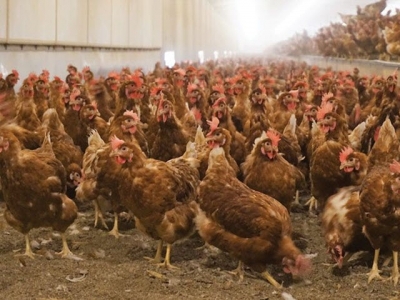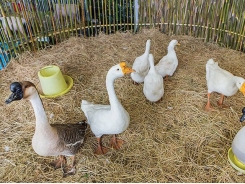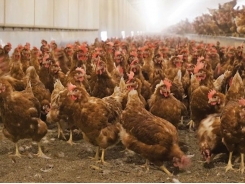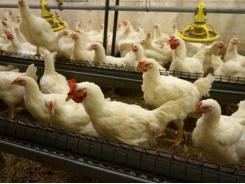Manipulation of poultry gut microflora with probiotics

Probiotics are an increasingly popular alternative to antibiotic growth promoters, but more research needs to be conducted.
Intestinal health status has a major influence on the performance of commercial poultry flocks. The normal microflora is an essential component of a healthy gastrointestinal (GI) tract, as the gut microflora is extensively involved in a wide array of physiological, nutritional, and immunological events.
The composition of the gut microflora can be modulated by antibiotic growth promoters (AGPs), and this is one of the main mechanisms of action of these compounds in improving the health and productivity of commercial flocks.
The removal of AGPs from poultry diets can result in changes to the microbial profile of the gut, and this removal, in some countries, has been associated with efforts to find suitable alternatives.
Any alternative should bring considerable benefits for poultry productivity. It must be capable of manipulating the intestinal flora in a way that can provide favourable conditions for the domination of beneficial bacteria and suppression of harmful bacteria.
Bacterial diversity
Bacteria are a diverse, and metabolically active, component of a healthy digestive tract, and there can be up to 1012 bacteria per gram of digesta. It is estimated that the number of bacterial species in the GI tract generally varies from 400 to 500. Newly hatched chicks obtain bacteria from the environment immediately after hatch and upon their placement at farm.
Bacterial profile, including species and numbers of each organism, is specific to each segment of the GI tract and can be influenced by a wide variety of factors, such as the pH of the digesta, digesta passage rate, gut immune system activity, and diet. It should be noted that commercial poultry kept under similar conditions often may not have the same bacterial species in a specific segment of the GI tract.
Bacteria acquire most of the nutrients required for growth and maintenance from the bird’s diet and, as a result, the diet can have a major influence on the total number and diversity of bacterial populations in the gut.
The gut microbiota becomes much more complex as the bird ages, and some bacterial species become dominant. According to a study conducted at the University of Georgia, the gut microbiota can also be influenced by the sex of a bird. The results of this study showed that similarity in gut bacterial profiles between male and female broilers was less than 30%.
Functions of gut microflora
The gut microflora is involved in a wide array of physiological, nutritional, and immunological events, which can directly, or indirectly, affect the health and productivity of commercial flocks
The normal population of microbes in the intestine protects the host animal from pathogenic microorganisms. It has been reported that beneficial bacteria, for example Lactobacillus acidophilus, were able to suppress the pathogenic effects of Clostridium perfringens in the small intestine of broiler chickens through inhibition of proliferation or toxin production.
In another study, Lactobacillus spp isolated from the chicken intestine had inhibitory effects on the growth of pathogenic bacteria such as Salmonella and Escherichia coli under in vitro conditions. This might have resulted from the production of organic acids in the intestine.
Manipulation of gut microflora and probiotics
Altering the intestinal microbial community with AGP alternatives has met with some success. To manipulate the gut microflora, it is fundamental to have a clear picture of the normal microbial profile in healthy poultry kept under commercial conditions. It is also essential to recognize how this profile can be developed and maintained in the gut.
A probiotic is defined as “a live microbial feed supplement which beneficially affects the host animal by improving its intestinal microbial balance”. Administration of probiotics is carried out to improve growth performance, to maintain or improve the intestinal tract’s health status, and to control food-borne pathogens.
Commercial probiotic preparations may be presented as single- or multi-strains and also as a blend of various species of bacteria. Multi-species products may have the benefit of being effective against a broader array of GI tract conditions.
In order to be effective, it is essential that the bacterial species in probiotics have the ability to reach their target organ in a viable form and in sufficient number. To achieve this goal, probiotics must be able to survive feed preparation processes (for example heat-based techniques), remain stable during short- or long-term storage of feed, and endure the low pH conditions existing in the proventriculus and gizzard.
Among the most important modes of action of probiotics are the suppression of harmful bacteria by producing antibacterial compounds, competition with pathogens for nutrients and binding sites, and stimulation of the immune system. However, the results of published studies on the effects of probiotics have not always been consistent.
Nevertheless, there are many reports in the scientific literature indicating the beneficial effects of probiotics on metabolism and production performance of broilers, laying hens and turkeys. These include enhanced digestibility of nutrients, increased body weight gain and feed efficiency, improved egg quality traits and rate of production, and reduced flock mortality.
Points to consider
The diversity of gut bacteria and a lack of a clear understanding of existing host-microflora interactions have led to difficulties in identifying effective types and amounts of bacterial species for inclusion in commercial probiotics. Additionally, the compatibility and/or synergism of bacterial species are two important factors that must be taken into consideration when designing multi-species probiotics.
Yet new developments in molecular biology have drastically increased knowledge of the effects that different factors, including dietary composition, can have on gut microflora profile and the possible consequences of these changes for the health and productivity of commercial poultry flocks.
When it comes to evaluating the efficacy of probiotics, it should be remembered that commercial field conditions are generally different from experimental settings, and the presence of stressors at commercial farm level may affect the gut microflora.
The route of administration is also important, as supplementation through feed or drinking water may not always lead to the same results. Drinking-water related factors, such as the use of chlorine sanitizers, may affect efficacy.
There have been some concerns over the labeling of commercial probiotics. A probiotic label should normally provide accurate information including the types and number of organisms, and assure that these numbers will remain active up to the expiry of the commercial product.
In a Canadian study, the labels of 44 probiotics (21 for human and 23 for animal use) were evaluated. The results revealed that the organisms were not properly identified in 43% of human and 35% of veterinary products. There were misspellings in the contents of 25% of human and 18% of veterinary probiotics. The contents were properly identified in only nine human and two veterinary probiotics.
As use of alternative feed ingredients is becoming more common in various parts of the world, it would seem essential to investigate how these new ingredients can influence the bacterial community of the gut. The results of these new investigations may provide additional information warranting a re-evaluation of those probiotics that are already commercially available.
About Authors:
Mojtaba Yegani is a PhD student.
Doug Korver is a professor of poultry nutrition at the University of Alberta, Canada.
Related news
Tools

Phối trộn thức ăn chăn nuôi

Pha dung dịch thủy canh

Định mức cho tôm ăn

Phối trộn phân bón NPK

Xác định tỷ lệ tôm sống

Chuyển đổi đơn vị phân bón

Xác định công suất sục khí

Chuyển đổi đơn vị tôm

Tính diện tích nhà kính

Tính thể tích ao




 When to use natural betaine in poultry diets
When to use natural betaine in poultry diets  Reducing stress in heavy breeders
Reducing stress in heavy breeders